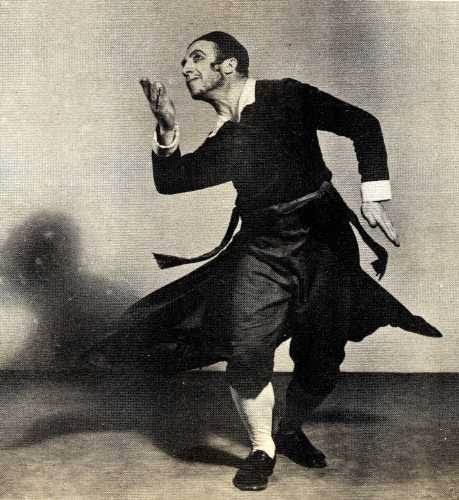
Research is fun when you trust the subconscious and the spontaneous.
My friend Yiss Mill sent me a video of the band he was playing with, Aljamia in Sydney. Their Eastern music was wonderful and their guest solo dancer was outstanding. I was inspired and made a 45-second video to send to Yiss. In the video I’m dancing to his music.
When he sent the video, I had been reading the online biography of the old actor Alan Arkin. He had played the grandfather in one of my favourite Non-Clown Clown movies, Little Miss Sunshine. In Arkin’s biography it mentions that he learned about Stanislavsky’s acting method from Benjamin Zemach (photo above) who had been a direct student of Stanislavsky in Moscow. Zemach became a significant acting teacher in Hollywood, however, he also had a dance career and even danced in NYC with Martha Graham when they were young. Dancing with them was Michio Ito!!
After I posted my video to Yiss on facebook, I went to search about Zemach. There was a single remnant of him dancing. In 1968 he did a brief performance of his 1922 solo, The Beggar. I saw a vague resemblance. Or at least some odd similarities even though we’re doing two different dances, with his a choreography made 100 years ago, and, mine a mere improvisation. In each super short dance, we are each in our late 60s.
After you see those, perhaps you will be interested in the exceptional article written in 2018, about Zemach’s artistic career. That long article is on a link below and the two very short videos are below that link. Here are a few excerpts from the article by Naima Prevots.
“In 1983, looking back at his youth in the theatre, Zemach summarized the influence of Stanislavsky, Vakhtangovand Meyerhold:
From Stanislavsky I learned about concentration, imagination, physica1 activity, purposefulness, relaxation, rhythm and the music of speech, as well as the divisions of parts into larger and sma11er sections, and the role of conflict and development. From Vakhtangov I learned inner continuity of gesture, composition, combination of content and form, as well as a sense of contemporaneity and the abstraction of flights of imagination. Meyerhold taught me to approach each work with freshness of mind and an attempt to look at the process at hand as opposed to past ventures. The influence of participating in The Dybbuk was pervasive throughout Benjamin Zemach’s career.”
Another excerpt from Prevots’ article: “Benjamin found in New York an active dance community, and it was there that he began to develop his choreographic interests.
One of the first performances Benjamin gave in New York was an evening shared with Jacob Ben-Ami and Michio Ito on September 25, 1928 at the Yiddish Folks Theatre. During this time Benjamin also became active in the group that worked and performed at the Neighborhood Playhouse. It was there that he performed with Martha Graham, Charles Weidman, Doris Humphrey, and Michio Ito and created several solo concert pieces. One of the dances Zemach still remembers is the one choreographed by Michio Ito to music by Claude Debussy, Fete et Nuages. As he wrote about it in 1983, he recalled, “I was a dark cloud who stole Martha Graham from Michio Ito.” Other concert pieces created during this time included The Beggars Dance, Roumanian Rhapsody (music by Enesco), and Tocatta and Fugue (music by Bach).
New York was Benjamin’s home base from 1928 to early 1932. During those years he conducted teaching and performing tours of Palestine, the West Coast and several eastern American cities. His performances in New York marked him as a figure to be watched and heralded. Elizabeth Selden, the critic, wrote of his impact in the The
Dancers Quest (1935).
“Benjamin Zemach goes even further back than does Doris Humphrey toward that ancient oneness in which the dance embraced all media of expression, serving as a repository for the epic memories of the race and as its confession of faith. He represents in America a unique type of ritual dancing, not only because it has the unmistakble ring of true adaption of some cult foreign to the dancer, but also because it represents a synthesis of all the “isms” that we have carefully been taught to separate into the desirable and the undesirable. Benjamin Zemach seems blissfully unaware of this distinction and emerges in the end with a composition fascinating for its exoticism, yet essentially right in every way. The transplanting from his native Moscow seems not to have impaired his creative talent. Somehow America is a crucible in which all metals mingle and melt, undergo chemicalizations that leave the right ones none the worse for their purging as well for use in new combinations. “ (Elizabeth Selden 1935 via Naima Prevots 2018) Dr. Prevots Biography and Publications link, and, Zemach article link:
https://prabook.com/web/naima.prevots/770181
https://www.israeldance-diaries.co.il/wp-content/uploads/2018/10/ANNUAL1986_benjamin_zemach.pdf
45-seconds thank you to Yiss and Aljamia band.